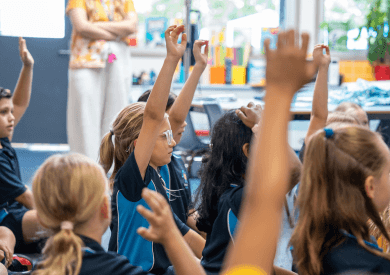Whole class discussion
Teachers carefully prepare and purposefully facilitate discourse, such as whole-class discussions that build on student thinking and guide the learning of the class in a productive disciplinary direction.
National Council of Teachers of Mathematics, 2014
In reSolve tasks, whole class discussion typically occurs during the Connect phase. This can be...
- ...straight after the Explore phase, if there is enough time for meaningful discussion.
- ...at the start of the following lesson, so that students (and the teacher) have plenty of time to reflect on the important ideas they encountered in the task.
The purpose of whole class discussion
The purpose of whole class discussion is to make the mathematics visible, so that students can develop their thinking beyond what they are able to do on their own or in small groups. Through discussions, teachers can build a thoughtful community of mathematical thinkers, where students actively participate in sharing their ideas and listening to those of others.
Whole class discussion provides one of the most productive means for students to compare their own reasoning with that of others, and to develop new mathematical understanding. When you intentionally select and sequence different student solutions and mathematical ideas, you encourage students to notice connections, which helps to make the mathematics more visible and explicit. It also helps to foster disequilibrium—that idea of cognitive reorganisation and reflection, which can promote deeper inquiry, and push students to form generalisations.
How does the teacher facilitate the discussion?
The teacher’s role is to craft questions around student solutions, so that the mathematics becomes visible to students during the whole class discussion. You do this by:
- Focusing on intentionally selected student solutions which reflect the mathematical learning goals of the task.
- Focusing the discussion on making connections between students’ solutions.
Using targeted, purposeful questioning steers students to see explicit connections between different student solutions and the task's mathematical goals. You can connect different student strategies to each other to make student thinking public and part of the students’ shared mathematical understandings.
You may ask students questions which:
- Ask why they used a specific strategy, rather than asking what they did.
- Emphasise specific connections between the student solutions and the lesson’s mathematical goals.
- Make the mathematics visible to the presenter and the listeners.
In making the mathematics visible, you guide students in noticing and building connections between mathematical concepts that they may have seen as disconnected. It is through this deeper understanding of the mathematics that students can begin to form generalisations.
References
Fosnot, C. T., & Dolk, M. (2001). Young Mathematicians at Work: Constructing Number Sense, Addition, and Subtraction. Heinemann.
National Council of Teachers of Mathematics. (2014). Principles to Actions: Ensuring Mathematical Success for All. Reston, VA: National Council of Teachers of Mathematics.
Smith, M. S., Bill, V., & Sherin, M. G. (2020). The five practices in practice: Successfully orchestrating mathematics discussions in your elementary classroom. Reston, VA: National Council of Teachers of Mathematics.
Smith, M. S. & Stein, M.K. (2018). 5 Practices for Orchestrating Productive Mathematics Discussions. National Council of Teachers of Mathematics.

